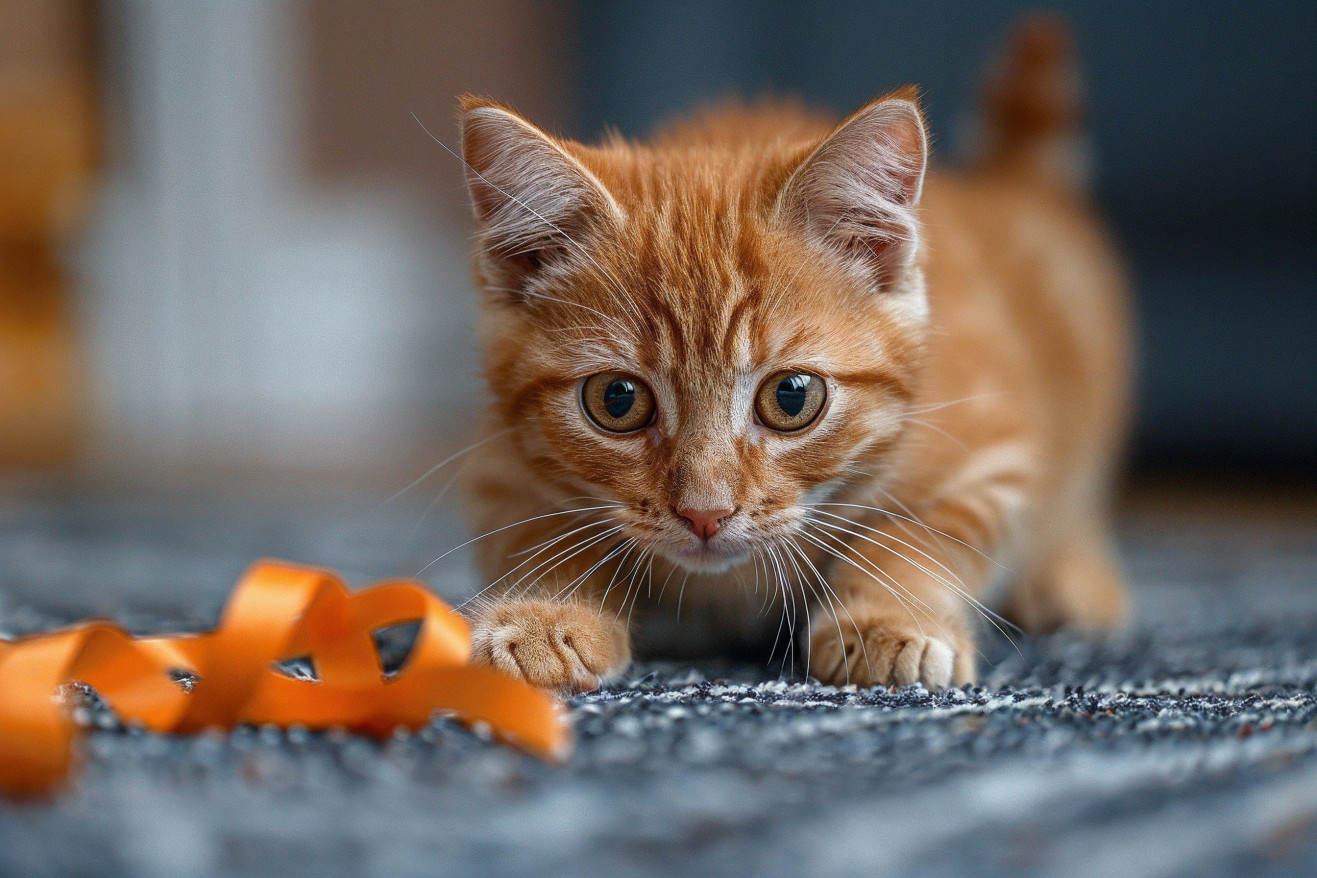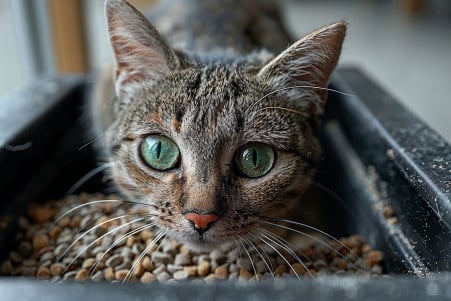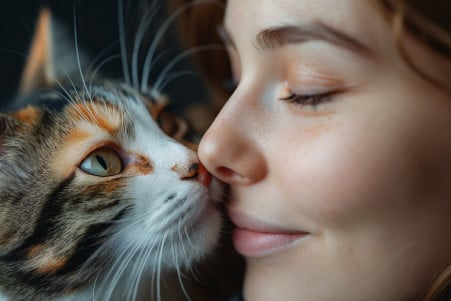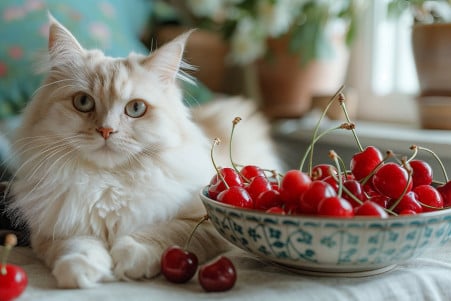If Your Cat Ate Ribbon: What to Do and How to Prevent It
8 March 2024 • Updated 7 March 2024

If your cat has recently played with a ribbon, you may be dealing with an emergency situation. Ribbon ingestion in cats can cause gastrointestinal obstruction, a life-threatening condition that can result in vomiting, lethargy, and abdominal pain. Treatment will require immediate veterinary intervention, possibly including surgery to remove the ribbon. To avoid this, make sure your cat can’t access ribbons in the future.
This article will take a deep dive into a wide range of veterinary science literature, covering everything from case studies and clinical reports to behavior analyses. Together, this research offers valuable information about the dangers, signs, and treatment of ribbon ingestion in cats.
We’ll also discuss how to use prevention and behavior modification to protect your cats from these dangers. Read on to learn information that can help you avoid emergencies and support your cat’s well-being in the long run.
What should you do if your cat ate ribbon?
How to Tell If Your Cat Has Eaten Ribbon
It is important to recognize the signs of ribbon ingestion in cats so that you can get your pet the help they need as soon as possible.
According to PDSA, the most common signs of ribbon ingestion in cats include vomiting, lethargy, and abdominal pain, all of which can be symptoms of gastrointestinal obstruction.
VCA Animal Hospitals also lists behavioral changes, like hiding, and physical signs of distress, like drooling and lip-smacking, as important symptoms to watch out for. PetMD warns that if ribbon ingestion is not identified quickly, it can lead to more serious issues, including dehydration, electrolyte imbalances, and even bowel rupture.
If you notice any of these symptoms in your cat or suspect that they have eaten ribbon, it is important to get them to a veterinarian right away. This is especially important because, as VCA Animal Hospitals explains, surgery to remove the obstruction may be necessary, and the outcome is better the sooner treatment is started.
Make sure to monitor your cat closely if you suspect they have eaten ribbon so that you can ensure that they get the help they need to recover.
Emergency Veterinary Treatment for Ribbon Ingestion
If you take your cat to the vet with suspected ribbon ingestion, it’s important that you act fast. According to PetMD, the veterinary team will typically start by conducting a complete physical exam to evaluate the cat’s overall health and then move on to diagnostic testing.
As a study on gastrointestinal foreign bodies by Trevor N Bebchuk on PubMed explains, imaging studies, including abdominal x-rays and ultrasounds, are important for confirming the presence of a foreign body. Bloodwork is another important diagnostic tool that vets use to determine a cat’s hydration and electrolyte levels.
The treatment that follows will depend on the diagnosis. According to PetMD, if the foreign body is still in the stomach, the vet may try to induce vomiting. More commonly, the vet will perform an endoscopy or surgery, including an enterotomy to remove the foreign object or a resection and anastomosis if the intestines are damaged.
The decision of which treatment to pursue will depend on factors like the type of foreign body and its location in the gastrointestinal tract and the severity of the cat’s symptoms, according to PDSA.
Once the treatment is complete, the focus will shift to the care and monitoring that the vet and the pet owner will need to provide to ensure the cat makes a full recovery. This will include giving medications, managing the cat’s pain, and providing nutritional care.
A cat’s successful recovery will depend on the collaboration between the professional care the cat receives from the vet and the care the cat receives at home. Because each case is unique, the period after treatment is important for ensuring that the cat is improving and that no complications arise.
Long-Term Effects of Ribbon Ingestion
One of the most important things to consider after a cat has survived ribbon ingestion is the long-term effects on the cat’s health.
Gastrointestinal obstructions can lead to chronic issues like adhesions or delayed gastric motility, which the cat will have to manage for the rest of its life.
The long-term outlook will depend on a variety of factors including how long the obstruction lasted, if there were any complications during surgery, and the cat’s overall health before the incident.
Cat owners will need to make sure that their cats are closely monitored and see their veterinarians regularly to ensure that they make a full recovery and to catch any complications early.
Cat owners can also help their cats recover by following their veterinarian’s instructions for postoperative care and making changes to their home to ensure that the incident doesn’t happen again.
This can include making sure that the cat has access to toys that are less likely to be ingested and creating a safe, stress-free environment for the cat to recover in. By doing this, cat owners can help ensure that their cats have the best chance of making a full recovery in both the short and long term.
How to Keep Your Cat From Eating Ribbon
In order to keep your cat safe from the dangers of ribbon ingestion, it’s important to take steps to prevent the behavior. Spruce Pets recommends keeping ribbons and similar items in a place that’s inaccessible to your cat to prevent them from getting into a situation where their curiosity gets the best of them.
By cat-proofing your home and keeping dangerous items in a secure location, you can help prevent the possibility of accidental ingestion.
It’s also important to make sure that your cat is supervised when they’re playing with string-like toys. This will help ensure that they can safely act on their predatory instincts while also preventing them from chewing or swallowing the toy when you’re not around.
CatTime recommends offering other toys that don’t pose a risk of ingestion, such as solid rubber balls or soft stuffed toys, to provide the mental and physical stimulation your cat needs without the risk that comes with string or ribbon toys.
You should also make sure that you’re providing regular environmental enrichment to prevent your cat from chewing on things out of boredom. PetMD notes that daily enrichment, such as puzzle feeders or interactive toys, is important for maintaining your cat’s mental and emotional well-being while also reducing the risk of destructive behaviors.
By doing this, you can help ensure that your cat is safe to play and explore without the risk of foreign body ingestion.
Solving the Mystery: Why Do Cats Eat Ribbon and Other Non-Food Items?
Cats eat ribbon and other non-food items because of a condition called pica. Pica is the consumption of non-nutritive substances like fabrics and plastics and can lead to intestinal blockages. According to The Honest Kitchen, pica can be caused by a number of factors, including stress, medical issues such as pancreatitis, and nutritional imbalances.
PetMD explains that certain cat breeds, particularly Siamese, Burmese, and Oriental cats, are more likely to develop pica. In addition, psychological and environmental factors such as early weaning, boredom, and loneliness can lead to pica. To help prevent and treat pica, professionals like veterinarians and animal behaviorists recommend environmental enrichment, which involves offering a variety of toys and activities, and ensuring that cats are eating a nutritionally complete diet, according to Furtropolis.
Preventing pica in cats requires an understanding of the condition’s causes. By working to reduce environmental stress, ensuring cats are eating a balanced diet, and seeking help from professionals, cat owners can help lower the risks associated with pica. This will help keep their cats safe from the dangers of consuming non-food items like ribbon and help them stay healthy and happy.
Final Thoughts on Ribbon Dangers for Cats
In conclusion, the innocent appeal of ribbons can result in dangerous consequences for cats. As both CatTime and PetMD point out, if cats eat these deceptively harmless objects, they can develop gastrointestinal obstruction, a life-threatening issue that requires immediate veterinary care. Knowing the early signs, including vomiting, lethargy, and abdominal pain, can be life-saving. An article on CatHealth.com also notes the importance of quick treatment to prevent long-term health problems.
It’s important to continue to monitor a cat’s health in the long term after an incident to make sure they fully recover and to prevent future issues, and to put measures in place to prevent future incidents.
This includes keeping these items out of reach and offering safe alternatives that still cater to a cat’s natural instincts. As Honest Kitchen suggests, understanding and changing a cat’s environment to prevent pica can also help reduce the risks.
As our pets’ caretakers, it’s our job to make sure our cats are safe and happy. With watchfulness and knowledge, we can protect our cats from common household dangers and help them explore their world in a safe and loving way.


